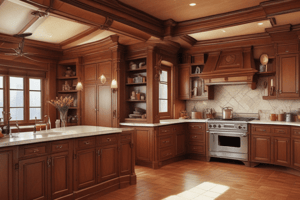Podcast
Questions and Answers
What is the main advantage of using veneer over solid wood?
What is the main advantage of using veneer over solid wood?
- Veneer is more sustainable than solid wood. (correct)
- Veneer is cheaper than solid wood. (correct)
- Veneer is easier to work with than solid wood. (correct)
- Veneer is stronger than solid wood.
Which veneer cutting method is most commonly used for hardwood face veneer?
Which veneer cutting method is most commonly used for hardwood face veneer?
- Rotary cut
- Flat cut (correct)
- Quarter sliced
- Half round cut
Which veneer matching method creates a mirrored pattern?
Which veneer matching method creates a mirrored pattern?
- Pleasing Match
- Book Match (correct)
- Random Match
- Slip Match
Which veneer assembly method involves stitching on the backside of the veneer?
Which veneer assembly method involves stitching on the backside of the veneer?
Which adhesive is best suited for cold pressing veneer?
Which adhesive is best suited for cold pressing veneer?
What is the main purpose of woodworking joints?
What is the main purpose of woodworking joints?
Which of these types of joints is typically used for constructing window frames?
Which of these types of joints is typically used for constructing window frames?
Which of these casework joints is a three-sided recess?
Which of these casework joints is a three-sided recess?
What is the primary purpose of a combination blade?
What is the primary purpose of a combination blade?
Which type of tooth design is primarily found on blades used for ripping?
Which type of tooth design is primarily found on blades used for ripping?
What is the primary difference between MDF and particle board?
What is the primary difference between MDF and particle board?
Which of the following is NOT a common thickness for MDF?
Which of the following is NOT a common thickness for MDF?
What is the main purpose of the layers being glued at right angles in plywood?
What is the main purpose of the layers being glued at right angles in plywood?
Which type of plywood is primarily used for construction and industrial applications?
Which type of plywood is primarily used for construction and industrial applications?
What is the primary difference between Medium Density Overlay (MDO) and High Density Overlay (HDO) plywood?
What is the primary difference between Medium Density Overlay (MDO) and High Density Overlay (HDO) plywood?
What are the thin sheets of solid wood used for making plywood called?
What are the thin sheets of solid wood used for making plywood called?
What is the primary reason for major design changes in millwork projects?
What is the primary reason for major design changes in millwork projects?
What is the primary difference between an RFI (Request for Information) and an IFA (Issue for Approval)?
What is the primary difference between an RFI (Request for Information) and an IFA (Issue for Approval)?
Which of the following is NOT typically included in a design drawing package for millwork projects?
Which of the following is NOT typically included in a design drawing package for millwork projects?
Which type of communication is used to clarify aspects of a project and gather missing information?
Which type of communication is used to clarify aspects of a project and gather missing information?
Which type of saw blade is primarily designed for making smooth cuts across the wood grain?
Which type of saw blade is primarily designed for making smooth cuts across the wood grain?
What is the key difference between architectural millwork and residential millwork in terms of design?
What is the key difference between architectural millwork and residential millwork in terms of design?
Which of the following is a characteristic of a crosscut blade?
Which of the following is a characteristic of a crosscut blade?
What is the primary application of a rip blade?
What is the primary application of a rip blade?
Flashcards
Architectural Millwork
Architectural Millwork
Communication and design collaboration between architect and millwork company, focused on detailed drawings before estimating.
Residential Millwork
Residential Millwork
Involves communication among owner, designer, and millwork company; design may vary during estimating phase.
RFI (Request for Information)
RFI (Request for Information)
A request to gather missing information or clarify project issues not included in the construction contract.
IFA (Issue for Approval)
IFA (Issue for Approval)
Signup and view all the flashcards
IFC (Issued for Construction)
IFC (Issued for Construction)
Signup and view all the flashcards
Millwork Shop Drawings
Millwork Shop Drawings
Signup and view all the flashcards
Rip Blade
Rip Blade
Signup and view all the flashcards
Crosscut Blade
Crosscut Blade
Signup and view all the flashcards
Flitch
Flitch
Signup and view all the flashcards
Veneer thickness
Veneer thickness
Signup and view all the flashcards
Rotary cut veneer
Rotary cut veneer
Signup and view all the flashcards
Book Match
Book Match
Signup and view all the flashcards
Stitching (veneer)
Stitching (veneer)
Signup and view all the flashcards
Dado joint
Dado joint
Signup and view all the flashcards
Mechanical fasteners
Mechanical fasteners
Signup and view all the flashcards
Plywood face matching
Plywood face matching
Signup and view all the flashcards
Combination Blade
Combination Blade
Signup and view all the flashcards
Triple Chip Tooth
Triple Chip Tooth
Signup and view all the flashcards
MDF
MDF
Signup and view all the flashcards
Plywood
Plywood
Signup and view all the flashcards
Softwood Plywood
Softwood Plywood
Signup and view all the flashcards
Hardwood Plywood
Hardwood Plywood
Signup and view all the flashcards
Overlay Plywood
Overlay Plywood
Signup and view all the flashcards
Veneer
Veneer
Signup and view all the flashcards
Study Notes
Architectural Millwork
- Communication happens between the architect and millwork company.
- More information is usually exchanged before the estimating phase.
- Design is set before the estimating phase.
- AWMAC (Architectural Woodwork Manufacturers Association of Canada) is a relevant association.
Residential Millwork
- Communication happens among the owner, designer, and millwork company.
- Design can change during the estimating phase.
- Construction standards are more diverse compared to other types.
- CKCA (Canadian Kitchen Cabinet Association) is a relevant association.
Type of Communication
RFI (Request for Information)
- Gathers information not initially included in the construction contract scope.
- Identifies missing specifications, e.g., hardware, appliances, finishes.
- Clarifies project aspects.
- Allows for necessary substitutions.
IFA (Issue for Approval)
- Documents or drawings need client, designer, and architect approval.
- Drawings contain all required information.
- RFIs might be asked for clarification.
- Back-and-forth communication is possible.
IFC (Issued for Construction)
- Includes changes in pricing, options, and site measurements.
- Drawings might reflect site measurements.
- Reviews and returns IFA to maintain build schedules.
- Drawings ensure accuracy for the millwork shop.
- Budget changes are often the main reason for major design adjustments.
Millwork Shop Drawings
- Drawings are used as a build guide by the millwork company.
- Design drawings form a specifications package containing all needed information.
- Information missing from design drawing includes finishing schedules, hardware details, accurate appliance specifications, and adequate detail.
Types of Saw Blades
Rip Blade
- Cuts along the wood grain.
- Large teeth with sharply angled hooks and deep gullets.
Crosscut Blade
- Cuts across the wood grain.
- Smaller teeth compared to rip blades.
- Should not be used for ripping.
- Alternate Tooth Bevel (ATB) types have varying tooth angles (neutral, negative, or smaller).
Combination Blade
- Used for both ripping and crosscutting.
- Not as fast or efficient as rip or crosscut blades.
- Teeth are grouped in sets of five.
Triple Chip Tooth
- Combination rip or crosscut blade.
- Used in materials like MDF and particle board.
- Flat-topped (rip) teeth in blade.
Sheet Goods
- Common sheet goods include plywood, MDF, particle board.
- Less common options include cork, glass, insulation, and metal.
Composition Boards
- Sheet goods made from fibers, chips, or flakes.
- Examples include MDF, particleboard, HDF/LDF, hardboard, OSB.
MDF (Medium Density Fiberboard)
- Thickness ranges from 2.5mm to 50mm.
- Common thicknesses include 6mm, 12mm, 19mm, and 25mm.
Particle Board
- Typical thicknesses range from 3/8" to 1 5/8".
- Often used in cabinet cores.
Plywood
- Composed of three layers of wood veneers.
- Wood veneer faces and a core layer.
- The core can be wood veneer, composition board, solid wood, or a combination.
- Veneer construction features face veneers, crossbanding, center ply, and back veneers.
Classes of Plywood
- Construction/Industrial (softwood ply): strength prioritised over appearance.
- Hardwood/Decorative (hardwood ply): appearance prioritised over strength.
Overlay Plywood
- Used for signs, work surfaces, and concrete formwork..
- Medium Density Overlay (MDO) is common, with high density overlay (HDO) featuring resilience.
Veneer & Veneer Patterns
- Thin sheets of solid wood cut from logs.
- Includes box, reverse box, checker, diamond, and reverse diamond.
- Matching includes slip, random, and pleasing.
Veneer Cutting
- Rotary cut: used by softwood veneer.
- Flat cut: used by hardwood veneer.
- Half-round cut: used to create curved veneers.
- Other methods include quarter slicing and rift cutting.
Plywood Face Matching
- Plywood pieces are assembled into a flitch (sequence of stacked veneers).
- Matching methods: book match (mirrored patterns), slip match (no flipping), random match (varying patterns), pleasing match (similar colours).
Other Veneer Patterns
- Different patterns for veneer like box, reverse box, checker, diamond, and reverse diamond.
- Veneer assembly methods include stitching, taping, and edge gluing.
Adhesives for Veneering
- Hot pressing: Cross-linked PVA or Urea formaldehyde.
- Cold pressing: Use of good wood glue (e.g., UF 109).
Woodworking Joints
- Purpose: Hold and support, add strength, and also for decorative purposes.
- Types: Dowel, Biscuit, Dovetail, Dado, Finger, etc..
Other Useful Joints
- Examples include Cross Lap, Middle Lap, Miter, Scarf, Spline, and Finger Joint.
Studying That Suits You
Use AI to generate personalized quizzes and flashcards to suit your learning preferences.


